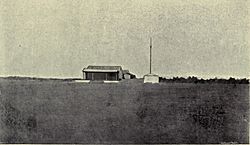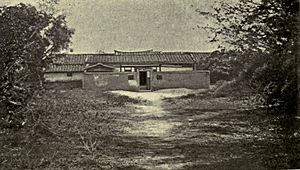Nerbudda incident facts for kids
Quick facts for kids Nerbudda incident |
|
|---|---|
| Part of the First Opium War | |

Parade Ground in Taiwan (now Tainan) where the British subjects were publicly executed
|
|
| Location | Taiwan, Taiwan Prefecture, Qing Empire (now Tainan, Taiwan) |
| Coordinates | 25°09′04″N 121°45′22″E / 25.1511°N 121.7561°E |
| Date | 10 August 1842 |
| Target | Survivors of the Nerbudda and Ann shipwrecks |
|
Attack type
|
Mass beheading |
| Deaths | 197 prisoners executed 87 dead from ill-treatment |
| Assailants | Dahonga Yao Ying |
The Nerbudda incident was a sad event that happened on August 10, 1842, during the First Opium War. It involved the execution of 197 people from two British ships, the Nerbudda and the Ann, in Taiwan. Another 87 prisoners died because they were treated very badly while held captive.
In September 1841, the Nerbudda ship was wrecked off northern Taiwan near Keelung. Then, in March 1842, the Ann ship also crashed near Da'an harbor. Most of the people who survived these shipwrecks were Indian workers and sailors, called lascars. They were captured and forced to march south to the capital city of Taiwan Prefecture, which is now Tainan. There, they were put in prison before being executed. Out of almost 300 people who landed in Taiwan, only 11 survived. The Daoguang Emperor of China ordered these executions on May 14, 1842, after Chinese forces lost a battle in Zhejiang province.
Contents
Why This Happened
The British East India Company was a powerful trading company. They wanted to expand their business in East Asia. They saw Taiwan, also known as Formosa, as a great place for trade because it had many resources. The Company even tried to convince the British government to take over the island.
In 1840, a British man named William Huttmann wrote to Lord Palmerston, who was in charge of foreign affairs. Huttmann said that Taiwan was important for trade and strategy. He believed that a British warship with fewer than 1,500 soldiers could easily take control of the island's eastern coast. During the First Opium War, British warships, called men-of-war, patrolled the waters around Taiwan and the Pescadores islands.
Shipwrecks and Lies
The Nerbudda Shipwreck
In early September 1841, the British transport ship Nerbudda left Hong Kong. It was heading to Chusan (Zhoushan) with 274 people on board. Most of them were Indians (243), along with 29 Europeans and two men from Manila.
A strong storm broke the ship's masts, and it drifted towards the northern coast of Taiwan. The ship hit a reef. All the Europeans, along with three Indians and the two Manila men, left the Nerbudda in a small rowboat. This left 240 Indians behind on the ship. These included 170 camp followers (people who traveled with armies or ships to provide services) and 70 lascars (sailors from India).
The ship stayed in the calm waters of Keelung bay for five days. The people on board tried to build rafts to reach shore. When they tried to land, some drowned in the waves. Others were killed by people on the shore who stole their belongings. The rest were captured by local officials. These officials split them into small groups and marched them south to the capital city of Taiwan (now Tainan). About 150 people are thought to have made it to shore. Meanwhile, those in the rowboat were rescued by another ship and taken to Hong Kong.
The Chinese general Dahonga and the local official Yao Ying sent a false report to the Daoguang Emperor. They claimed they had sunk the Nerbudda from the Keelung fort during a naval attack on September 30. They said they killed 32 enemies and captured 133. The emperor believed them and sent rewards to both commanders. However, no battle ever happened. The people they claimed to have killed were the shipwrecked survivors. Only two of these survivors, the head and second serang (a type of sailor), were later sent to Xiamen (Amoy) after the executions the next year.
The Ann Shipwreck
In March 1842, another ship, the brig Ann, sailed from Chusan to Macao. It had 57 people on board: 34 Indian natives, 14 Europeans or Americans, five Chinese, and four Portuguese or Malays. Most were seacunnies (helmsmen) or lascars.
Strong winds pushed the ship towards the shore, and the tide caused it to get stuck near Da'an harbor. The crew tried to take over a Chinese junk (a type of Chinese sailing ship) to get back to sea, but a storm stopped them. Soon, armed Chinese captured them.
General Dahonga and Yao Ying again sent a false report to the emperor. They claimed that local fishing boats had destroyed the ship while defending themselves. Only nine survivors from the Ann were spared from the executions in August 1842. In 1843, a list of the 57 crewmen and what happened to them was published:
- 43 were executed
- 2 died in prison
- 2 died in the shipwreck
- 1 escaped
- 8 were set free and sent to Xiamen (six were European or American, one was Indian, and one was Chinese)
- 1 Chinese person was kept as an interpreter
Attempts to Rescue
From October 19 to 27, 1841, the British warship Nimrod sailed to Keelung. Its captain offered 100 dollars for every Nerbudda survivor. But after learning that the survivors had been sent south to prison, Captain Joseph Pearse ordered his ship to bomb the harbor. They destroyed 27 cannons before returning to Hong Kong.
On October 8, 1842, Commander William Nevill of the Serpent left Xiamen for Taiwan (Tainan). Captain Henry Ducie Chads of the Cambrian told him to ask about the survivors of both ships "under a Flag of Truce" (meaning a peaceful visit). By this time, the British knew that most of the captives had already been executed. Nevill brought a letter from Chads to the Taiwanese governor, asking for the survivors to be released. However, Nevill reported that he was not treated kindly, and his letter was not accepted. He was told that the last survivors were being sent to Fuzhou. On October 12, they returned to Xiamen.
When the Serpent arrived in Anping, they found 25 survivors from another ship, the Herculaneum. This ship had left Singapore on September 6, 1842, carrying coal. Unlike the Nerbudda and Ann survivors, Captain Stroyan and his crew from the Herculaneum were treated well. However, they were always afraid because they knew what had happened to many other shipwreck victims. It seems that the Taiwanese officials mostly spared the European survivors, focusing their executions on the Indian (lascar) crew.
Reports from that time say that out of the Nerbudda and Ann crews, 197 people were captured. 30 died, and 157 were executed. This included eight Britons, one of whom was Robert Gully, the son of a famous boxer and politician. The 10 survivors were sent to Xiamen. The Serpent arrived in Xiamen with the Herculaneum survivors on October 12. The survivors from the Nerbudda and Ann did not arrive until October 25, almost two weeks later.
The Executions
After the Nerbudda survivors were captured, General Dahonga and Yao Ying asked for permission from Beijing (the capital of China) to execute them. They claimed the survivors were invaders. On May 14, 1842, the Daoguang Emperor gave the order. This happened after British forces successfully fought off a Chinese attempt to take back Ningbo in Zhejiang province.
Regarding the Ann prisoners, the Emperor ordered: "After getting their confessions, only the leaders of the rebellious 'yi' [meaning barbarians, a disrespectful term for foreigners] should be imprisoned. The remaining rebellious 'yi' and the 130-odd that were captured last year shall all be immediately executed to release our anger and enliven our hearts." On August 10, the captives were taken a few miles outside the city walls and executed.
Sadly, 87 other prisoners died from very bad treatment while they were held captive. A merchant named Robert Gully and Captain Frank Denham kept journals while they were imprisoned. Gully was executed, but Denham survived. On October 25, one of the freed survivors, Mr. Newman, received a page from Gully's journal. A Chinese soldier said he got it from Gully's shirt, which was taken off him at the time of his execution. This page contained Gully's last diary entry, dated August 10. The journals of Gully and Denham were published in London in 1844. In 1876, a memoir by Dan Patridge, a survivor of the Ann, was also published.
What Happened Next
On November 23, 1842, the British representative Henry Pottinger strongly condemned the killing of these non-combatant people. He demanded that the Taiwanese officials responsible be removed from their positions, punished, and have their property taken away. This money would then be paid to the British government as compensation for the families of those who were executed.
Pottinger stated that he had proof the emperor ordered the executions. However, he also said it was because the Taiwanese officials had lied. They falsely reported that the shipwrecked people were a hostile group who attacked the island, even though the ships were not warships and the captured crew were not soldiers.
The Chinese government was worried about the consequences. They had just finished peace talks and signed the Treaty of Nanking a few months earlier. On January 11, 1843, the emperor ordered an investigation into Dahonga and Yao Ying.
The governor of Fujian and Zhejiang, Yiliang, was sent to Taiwan (Tainan) to investigate. After his investigation, he reported that both commanders confessed to sending false reports about defending against a naval attack. In April 1843, they were called back to the capital, Beijing. After being questioned, they were put in prison but released by the emperor on October 18, after serving only 12 days. Later that year, Yao Ying claimed that he had lied to boost the spirits of Chinese officials and soldiers, which were low at the time. On December 16, Dahonga was given a new job in Hami, Xinjiang province. Yao Ying received a new job in Sichuan province. The British government did not know about these new jobs until the Governor of Hong Kong, John Francis Davis, told Lord Aberdeen on March 11, 1845.
In 1867, 25 years after the executions, a British doctor named William Maxwell interviewed an old Chinese clerk in a Tainan business. Maxwell asked if the clerk remembered the executions. The clerk said yes and claimed that on the same day, a huge thunderstorm happened and lasted for three days. He said it drowned an estimated 1,000 to 2,000 people. He believed it was "a judgment from Heaven for beheading the Foreigners."
Images for kids




